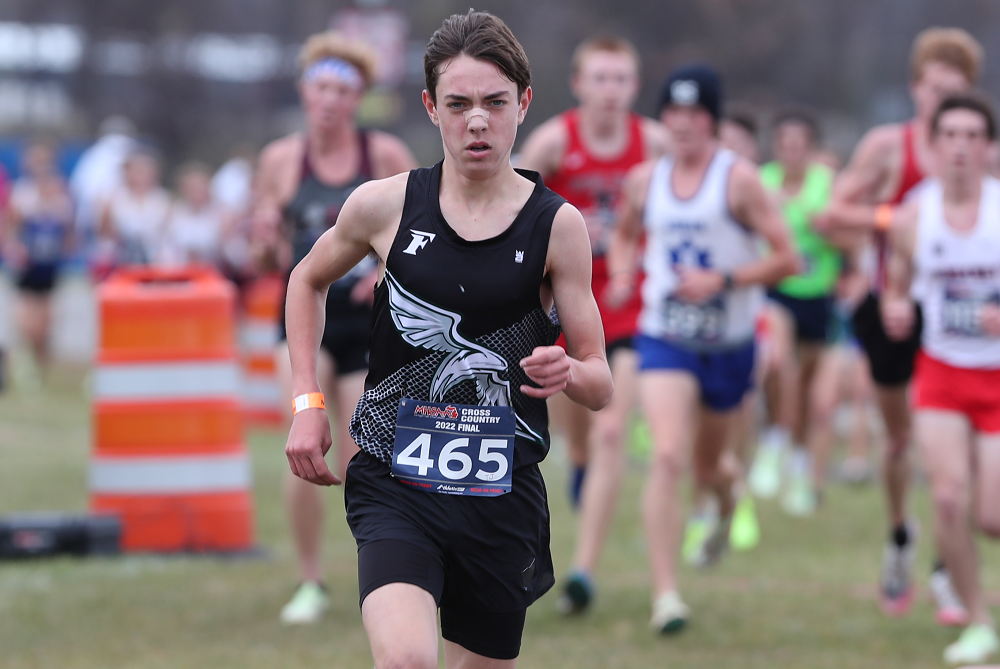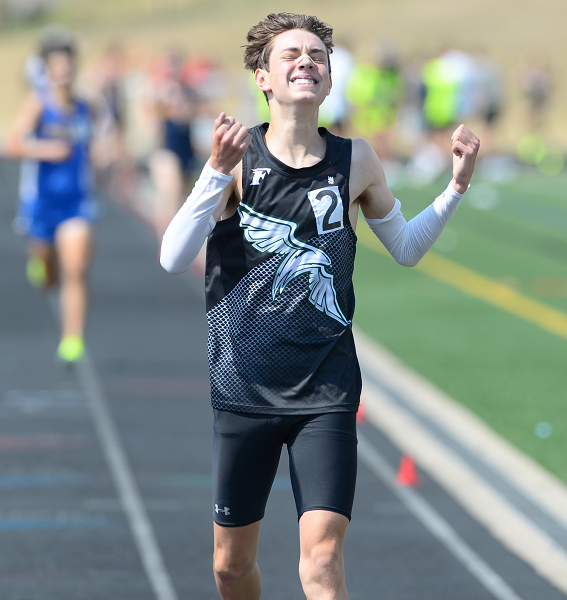
Raymond's Race to Remember
November 12, 2012
By Geoff Kimmerly
Second Half editor
Over the past nine days, Nick Raymond has replayed his best high school cross country race over and over in his memory.
He starts from the beginning and goes right through the finish line – while enjoying especially his surge during the second of the 3.1-mile Lower Peninsula Division 3 Final on Nov. 3 at Michigan International Speedway.
“If I hadn't done that, it could’ve been a difference race,” Raymond admitted Monday.
Instead, it was one of the best Division 3 races run in MHSAA history.
The Erie Mason senior received a Second Half High 5 after claiming his school’s first overall individual championship in 15:05.1, the second-fastest Division 3/Class C Finals time behind only that of Ovid-Elsie’s Maverick Darling in 2007. Raymond's also was the second-fastest time run at the Finals this fall.
And it was a redeeming way to finish his high school cross country career. Raymond found himself at the front of the Division 3 pack as a junior in 2011, but finished fourth. But he started this race with a speedy 4:39 mile and then kicked into another gear halfway home, which was his strategy all along.
“I've just been doing that all year, and it seemed to be working time-wise,” Raymond said. “If I do it then, and I can pull away, it gets into (my opponents') minds that they could get beat.”
Erie Mason has a solid running tradition. It finished 16th as a team this fall and won Division 3 in 2006. Matthew Waldfogel took first among individual finishers in the 1994 Class C Final, when team and individual qualifiers ran separate races, although his time would've tied for only second if both had been run together.
Raymond’s final season puts him at the top of individuals who have come through the program.
He finished his freshman year as the team’s number two runner, and “just progressively got faster,” Erie Mason coach Alison Meisner said. By the end of last fall, Raymond had the school record with a best of 15:59, his time at MIS.
But the best was yet to come.
"He had lots of natural talent, but he has a really good worth ethic," Meisner said. "He's very goal-oriented. He's just a little more driven to work at goals he sets for himself."
When he opened this season at the Ottawa Lake Whiteford Invitational by running 15:59 again, Meisner knew her standout might show more than just the usual improvement that comes from going from junior to senior.
Raymond’s moment of realization came two weeks later when he ran a 15:26 at the New Boston Huron Invitational.
“I realized I could go much faster,” he said. “I was pretty tired, because it was the first time I ever went that fast. But whenever I get a p.r. (personal record), I feel like I could go faster.”
Raymond ran 15:16 a week later at the Oregon Cardinal Stritch Invitational near Toledo, and then 15:15 or better three times before cutting 10 more seconds at MIS.
Oddly enough, the subject of Darling – now a standout at the University of Wisconsin – came up after Raymond beat the field by more than a minute with a 15:15 at his Regional.
An opposing runner quipped that Raymond might have dominated, but he wasn't Darling just yet.
But he’s getting closer. And Raymond too hopes to continue running at the highest level next fall.
“They were dogging me that I wasn't as good as Maverick Darling was,” Raymond said. “But my friends said it was sweet that I was even mentioned in the same sentence as him.”
PHOTO: Erie Mason senior Nick Raymond charges down the home stretch on the way to winning the MHSAA Lower Peninsula Division 3 championship at Michigan International Speedway. (Click to see more from HighSchoolSportsScene.com.)

Freeland's Hansen Not Focused on Joining All-Time Greats - But On His Way
By
Paul Costanzo
Special for MHSAA.com
September 29, 2023
The goal written on Matt Kaczor’s Post-It Note was sub-15 minutes, 15 seconds. That’s what the Freeland cross country coach was hoping for from star runner TJ Hansen during his junior season.
 Kaczor tore it up after seeing Hansen run a single race this fall.
Kaczor tore it up after seeing Hansen run a single race this fall.
“Knowing what he did over the summer and where he was at, seeing what his 1,600 (meter) and his mile got down to, I had a feeling he could get under 15:30 quickly,” Kaczor said. “After the first race, I looked at my assistant and was like, ‘I’ve gotta rip up that Post-It Note. I don’t think our goal is on the level of where he’s at right now.’ At first, it was break 15:15. Once I saw him race at the Under the Lights (on Aug. 18 at St. Johns), I was like, ‘Yeah, he’s going sub 15.’”
Hansen ran 15:39.6 in that first race, and on Sept. 7, in Shepherd, he ran 15:13.9 to meet the goal written on the now-shredded Post-It Note.
This past Saturday, he ran 15:03.7 at the Cadillac Veterans Serving Veterans Invitational. It’s the fastest time recorded in Michigan this year, and a signal that Kaczor might be filling out a new Post-It Note before the season is out.
“The sub-15 barrier, that’s been something on my mind for a while,” Hansen said. “Now that I’m edging closer and closer to that, it’s been exciting. With how heavy my training has been, I wouldn’t expect (to have run this fast this early). Being able to run the times I am really paints the picture for what’s ahead.”
Hansen came into the season already regarded as one of the elite distance runners in the state. He won the 3,200 meters at the MHSAA Lower Peninsula Division 2 Track & Field Finals this past spring. He’s also finished all-state (12th and fifth, respectively) the past two seasons at the LPD2 Cross Country Finals.
His current trajectory, however, would put his name near some of the state’s all-time greats. But that’s not something Hansen is focusing on.
“I really don’t like to compare myself to others,” he said. “I don’t focus on that. I try to be the best TJ Hansen that I can be. The best version of myself.”
Focusing on himself is almost necessary for Hansen, as he’s spending a lot of time during his races running by himself.
At each of the big events Freeland has run in this season, Hansen has finished at least 20 seconds ahead of his nearest competitor. That includes all divisions of the Duane Raffin Festival of Races in Holly.
In Cadillac, where Hansen ran his current best time, he was a full minute ahead of the rest of the field.
 “He’s just a special athlete,” Kaczor said. “I can’t see Freeland having someone like this in a while. He’s a generational talent. What’s crazy is, I had the school record when he was a freshman. He and Braden (Honsinger) broke it last year. But TJ has now dropped that school record (set in 1998) by almost a minute.”
“He’s just a special athlete,” Kaczor said. “I can’t see Freeland having someone like this in a while. He’s a generational talent. What’s crazy is, I had the school record when he was a freshman. He and Braden (Honsinger) broke it last year. But TJ has now dropped that school record (set in 1998) by almost a minute.”
Hansen’s achievements have already put him on a path to run at the next level, which is something of a family tradition.
His older sisters Peyton and Kiera are track & field athletes at Wayne State and Eastern Michigan, respectively. Their parents, Tim and Pam, were track & field stars at Central Michigan.
TJ has drawn the attention of coaches around the country, including from Michigan, Michigan State, Wisconsin, Tennessee and Colorado.
Having family members who know the process is a help for Hansen, and he said they’ve all been good about allowing him to choose his own path, whatever that may be.
“He’s from a good family that knows how to work and knows how to get things done,” Kaczor said. “He knows that if he puts in the work, he’s going to be at a good spot.”
While Hansen admits it can be a bit overwhelming, he’s using it as motivation to run faster and continue to put his name out there.
Also serving as motivation is 2022 Division 2 champion Connell Alford of Chelsea. Alford is among the elite group of runners in Michigan who have broken the 15-minute mark, doing it twice a year ago.
He currently has the state’s second-best time behind Hansen’s this year, running 15:09.1 at the MSU Invitational on Sept. 15.
“Whenever I see him drop a time, my main goal is to run faster,” Hansen said. “Whenever I see him run a good time, that motivates me to work hard.”
The two won’t see each other until the MHSAA Finals on Nov. 4 at Michigan International Speedway. It’s an opportunity Hansen is excited for, as it’s a chance to race and be pushed toward the lofty goals he’s set for himself. Kaczor is excited about it, too, even if it might mean having to replenish his supply of Post-Its.
“We don’t talk about winning the state title; we talk about making sure that we have great races on those days,” Kaczor said. “We can’t control how somebody else runs. It’s a matter of can we, if the weather is right and the course is in good condition, can we be one of the few guys that has run in the 14s on that course? That’s the goal. Put yourself in some great categories with those upper echelons and the greats of all-time.”
 Paul Costanzo served as a sportswriter at The Port Huron Times Herald from 2006-15, including three years as lead sportswriter, and prior to that as sports editor at the Hillsdale Daily News from 2005-06. He can be reached at [email protected] with story ideas for Genesee, Lapeer, St. Clair, Sanilac, Huron, Tuscola, Saginaw, Bay, Arenac, Midland and Gladwin counties.
Paul Costanzo served as a sportswriter at The Port Huron Times Herald from 2006-15, including three years as lead sportswriter, and prior to that as sports editor at the Hillsdale Daily News from 2005-06. He can be reached at [email protected] with story ideas for Genesee, Lapeer, St. Clair, Sanilac, Huron, Tuscola, Saginaw, Bay, Arenac, Midland and Gladwin counties.
PHOTOS (Top) Freeland's TJ Hansen leads a pack during last season's LPD2 Final at Michigan International Speedway. (Middle) Hansen enjoys a moment of exhilaration after winning the 3,200 this spring at the LPD2 Finals at Ada Forest Hills Eastern. (Top photo by Carter Sherline/Run Michigan; middle photo by Dave McCauley/Run Michigan.)

